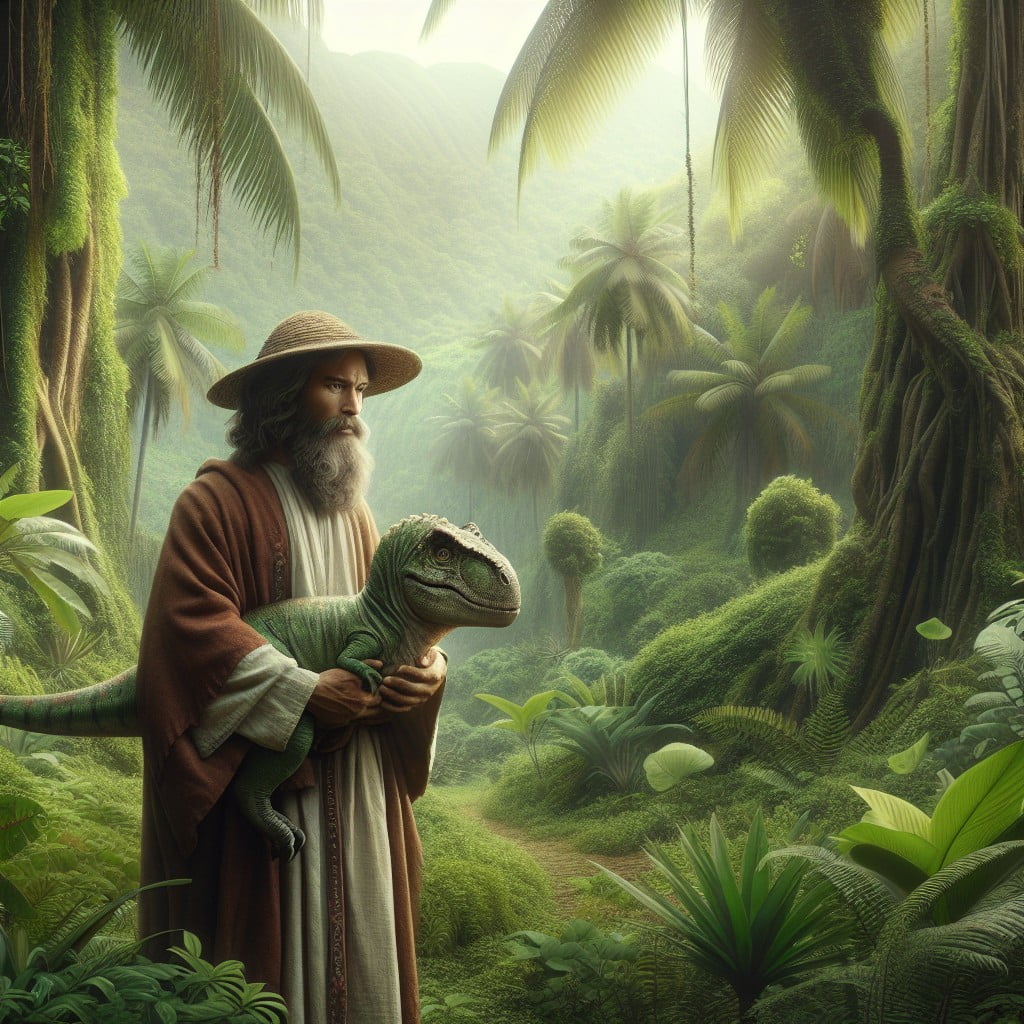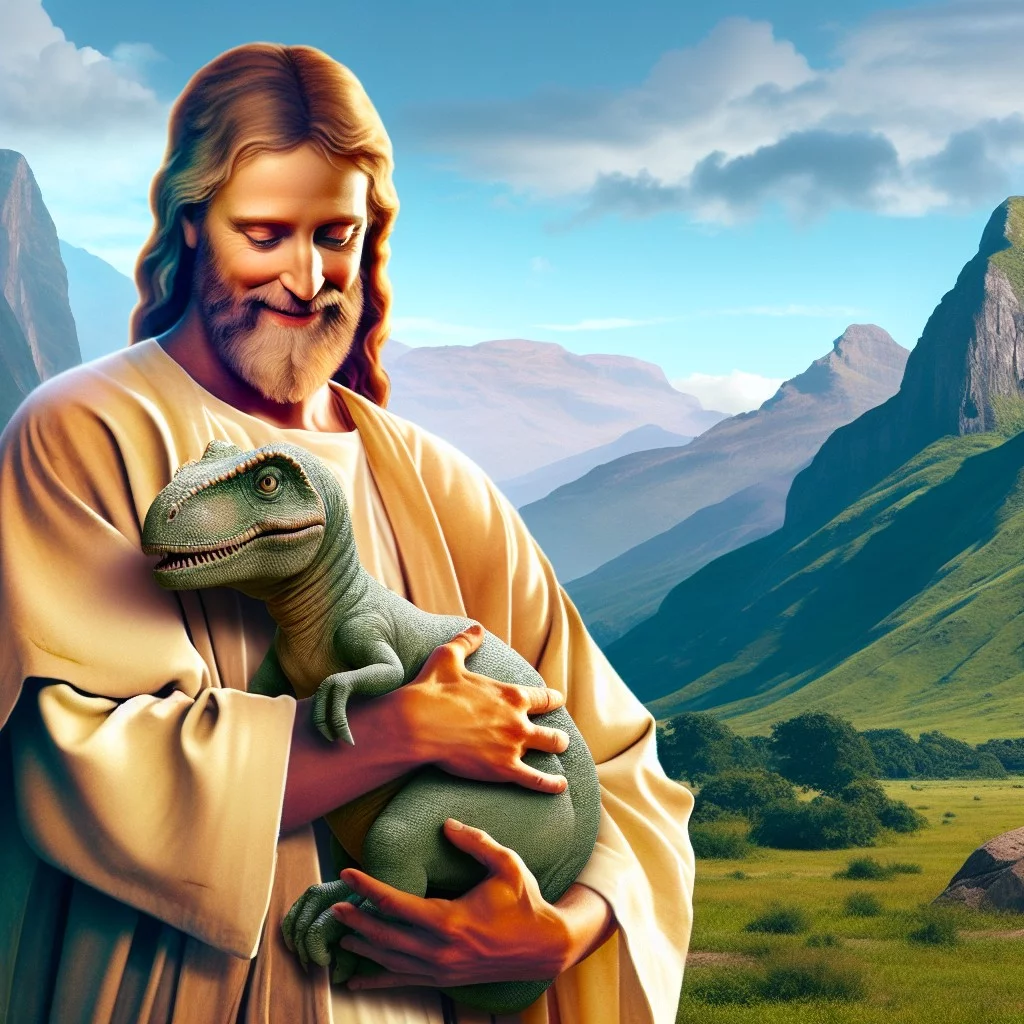Dive into this article because it explores the unique artistic intersection of religious and prehistoric worlds, embodied in the enigmatic tableau of Jesus holding a dinosaur unveiled at the new contemporary art exhibition.
Key takeaways:
- Varying religious beliefs influence perception of history and science.
- Imagery used in debates between creationist and evolutionary viewpoints.
- Metaphor and allegory in religious illustrations may not be literal.
- Jesus holding a dinosaur sparks broader discussions on faith and reason.
- Artistic representations bridge science and faith, provoke dialogue.
Understanding the Imagery of Jesus Holding a Dinosaur

The concept of Christ clasping a prehistoric creature challenges chronological and theological norms, often sparking intense discourse. This juxtaposition is not found in traditional texts nor supported by mainstream science, and typically emerges from particular interpretations of religious doctrine. Proponents of Young Earth creationism argue for a world where humans and dinosaurs coexisted, interpreting biblical scripture to suggest a relatively recent creation of the Earth.
On the other side of the spectrum, advocates of evolutionary theory and an old Earth contend that the image is an anachronism, as scientific evidence places the extinction of dinosaurs millions of years before the birth of Jesus. Therefore, to best grasp the significance of such imagery, consider the following:
- Assess how varying religious beliefs influence the perception of history and science.
- Examine how such images are used in discussions or debates between creationist and evolutionary viewpoints.
- Understand the role of metaphor and allegory in religious illustrations that may not be meant to depict literal scenarios.
- Acknowledge that such imagery, while provocative, can serve as a cultural touchstone for broader discussions on faith and reason.
Exploring these points can shed light on why the imagery of Jesus holding a dinosaur exists and what it symbolizes within different communities.
Historical Context of Depicting Jesus With Dinosaurs

In exploring the juxtaposition of Jesus and dinosaurs, it’s crucial to acknowledge the lack of historical overlap; dinosaurs predated Jesus by millions of years. This depiction primarily stems from certain Christian denominations that support Young Earth creationism, which posits that the Earth is thousands, not billions, of years old, contradicting established scientific consensus.
These representations are a recent phenomenon, gaining prominence in the late 20th century with the rise of creationist museums and literature. They serve as visual tools in the narrative that humans and dinosaurs coexisted, aiming to validate a literal interpretation of the biblical creation story from the Book of Genesis.
Notably, the images of Jesus with dinosaurs are not found in ancient Christian art or scripture, but they have become symbolic in certain contemporary religious circles for the belief in biblical inerrancy. The intent is to challenge the theory of evolution and to support the notion of a Creator orchestrating all aspects of life, including the existence of dinosaurs.
Cultural Impact of Jesus and Dinosaur Imagery
The concept of Jesus alongside dinosaurs resonates deeply within modern popular culture, challenging some traditional narratives while emboldening others. This intriguing juxtaposition has sparked conversations across various spheres:
- Educational Influence: It often serves as a visual tool for those advocating for alternate historical and scientific timelines consistent with creationist beliefs.
- Literature and Media: Books, comics, and films have adopted this imagery, shaping stories that blend religious texts with science fiction elements, thereby captivating diverse audiences.
- Social Media Trends: The motif has been popularized on online platforms, sparking memes and viral content that question or humorously combine scientific and religious discourse.
- Thought-Provoking Art: Artists have utilized this imagery to explore themes of time, existence, and belief, creating works that inspire audiences to reconsider historical and theological premises.
- Interfaith Dialogue: Presentations of such images can foster discussions between those of different faiths and scientific backgrounds about the origins of life and historical timelines.
Through these points of impact, the iconography serves as both a bridge and a battleground for various ideologies, generating a robust dialogue about faith, science, and their place in contemporary society.
The Creationism Debate Surrounding Jesus and Dinosaurs
The juxtaposition of Jesus and dinosaurs serves as a visual focal point in the ongoing conversation between creationism and evolution. Creationists assert that dinosaurs and humans coexisted, positing a young Earth timeline consistent with a literal interpretation of the Bible. They interpret biblical texts, such as Genesis, as historical accounts, hence the image of Jesus with prehistoric creatures bolsters their narrative.
Contrastingly, scientists advocate for a deep-time perspective based on extensive fossil records and radiometric dating techniques, suggesting dinosaurs became extinct about 65 million years before humans emerged. This view aligns with the theory of evolution, as outlined by Charles Darwin, which details the gradual development of species through natural selection over millions of years.
The creationism debate raises critical discussions on topics like the integration of religious beliefs in educational curricula, influencing not only academic circles but also political and social spheres. Instances where this image might surface include museum exhibits, educational materials, and themed amusement parks, each scenario impacting interpretations of scientific evidence and religious teachings.
Artistic Representations of Jesus Holding a Dinosaur
In various forms, artists have explored the concept of Jesus with a dinosaur to provocative effect. These depictions range from traditional paintings to modern digital illustrations, often stirring debate regarding historical accuracy and religious interpretation.
Some represent these images as a metaphorical bridge between science and faith, suggesting a coexistence of religious narratives with paleontological evidence. Others may use the imagery satirically, questioning the literal interpretation of ancient scriptures in the light of scientific discoveries.
These artistic endeavors can also serve as a commentary on the broader Creationism versus Evolution debate, visually portraying the tension between differing viewpoints on the origin and history of life on Earth.
Whether viewed as controversial or thought-provoking, such representations undeniably spark conversation and reflect the ongoing dialogue between art, religion, and science.
Theological Implications of Jesus Interacting With Dinosaurs
The conflated concept of Jesus and dinosaurs coexisting has stirred theological discussions. Traditionally, Christian teachings place the life of Jesus in a historical context far removed from the prehistoric era of dinosaurs. This juxtaposition raises several points:
1. Interpretation of Scriptures: This image challenges some traditional interpretations of the Bible which suggest Earth is thousands, not billions of years old.
2. Young Earth Creationism: Proponents argue that Earth was created over six days, which includes humans and dinosaurs cohabiting before the fall of man, supporting the possibility of such interactions.
3. Gap Theory: Between the first two verses of Genesis, some scholars propose a time lapse long enough to encompass the age of dinosaurs, separating their existence from that of humans.
4. Theism vs. Science: The depiction underscores the ongoing discourse between theistic belief systems and scientific evidence regarding the Earth’s timeline.
5. Allegorical Teaching: Some view the image as symbolic, emphasizing dominion or stewardship themes present within Christian teachings, rather than as a literal historical portrayal.
These points reflect the multifaceted nature of how faith and science intersect within the framework of religious art and education.
Public Reactions to Jesus and Dinosaur Exhibits
Public reaction to exhibits showcasing Jesus in the presence of dinosaurs spans a spectrum from fascination to skepticism. Many visitors are drawn to the novelty and are intrigued by the reimagining of historical timelines. Others view these displays as educational opportunities to discuss varying worldviews, particularly around the origins of life on Earth.
Critics, however, often express concerns about the scientific accuracy of these presentations. They argue that such exhibits can blur the line between faith-based perspectives and empirical science, potentially confusing the public’s understanding of history and evolution.
Supporters of these exhibits find them to be powerful tools for faith affirmation, bridging biblical narratives with physical history. This blend of faith and paleontology garners interest and serves as a talking point for discussions on theology and science.
Nevertheless, the diverse reactions are also reflective of broader societal debates about education, religious freedom, and the role of science in public spaces. Opinions vary significantly by community, upbringing, and individual belief systems, contributing to the ongoing discourse on how history, both human and prehistoric, is represented and taught.
The Commercialization of Jesus and Dinosaur Images
The fusion of religious icons with prehistoric creatures has found its way onto various consumer products, capitalizing on the curiosity and amusement of such anachronistic pairings. Merchandisers craft everything from t-shirts and posters to toys and novelty items featuring these images, catering to niche markets with a penchant for the unconventional.
Points to understand the commercialization aspect include:
- Target Audience: These products often appeal to those fascinated by religious iconography, dinosaur enthusiasts, or collectors of unusual memorabilia.
- Branding: The unusual combination of elements creates a distinct brand identity which can stand out in a crowded marketplace.
- Marketing Tactics: Sellers might leverage the controversial or humorous nature of the imagery to generate buzz and attract attention on social media platforms.
- Cultural Statements: Some consumers may purchase items as a statement of personal beliefs or to spark conversation about the intersection of faith and science.
Legal and Ethical Considerations in Displaying Jesus With Dinosaurs
Public institutions must navigate First Amendment implications when depicting religious figures, such as Jesus, especially alongside secular concepts like dinosaurs. Endorsing a specific religious viewpoint or mythos could infringe upon the separation of church and state. Museums and educational spaces often work with legal counsel to ensure that exhibits maintain educational intent rather than religious advocacy.
Privately-owned venues have more freedom yet may consider the ethical implications of their displays. They weigh the potential to misinform the public about historical timelines against the influence of artistic creativity. The impact on various demographic segments—including impressionable children—and the reinforcement of certain worldviews feature prominently in ethical discussions.
Moreover, intellectual property rights can come into play when using the likenesses of prominent religious figures. Creators may need permission to use the visage of Jesus, which often falls into a gray area given its widespread usage and historical significance. Copyright concerns necessitate careful navigation to avoid legal infringements.
Lastly, community standards and sensitivity to cultural perspectives play a role in ethical considerations. Diverse religious beliefs within communities prompt venues to be mindful of the potential for offending or alienating visitors. Dialogues with community leaders can help in striking a balance between educational goals and respect for differing beliefs.